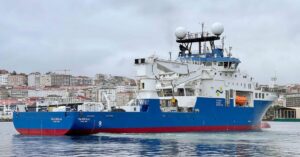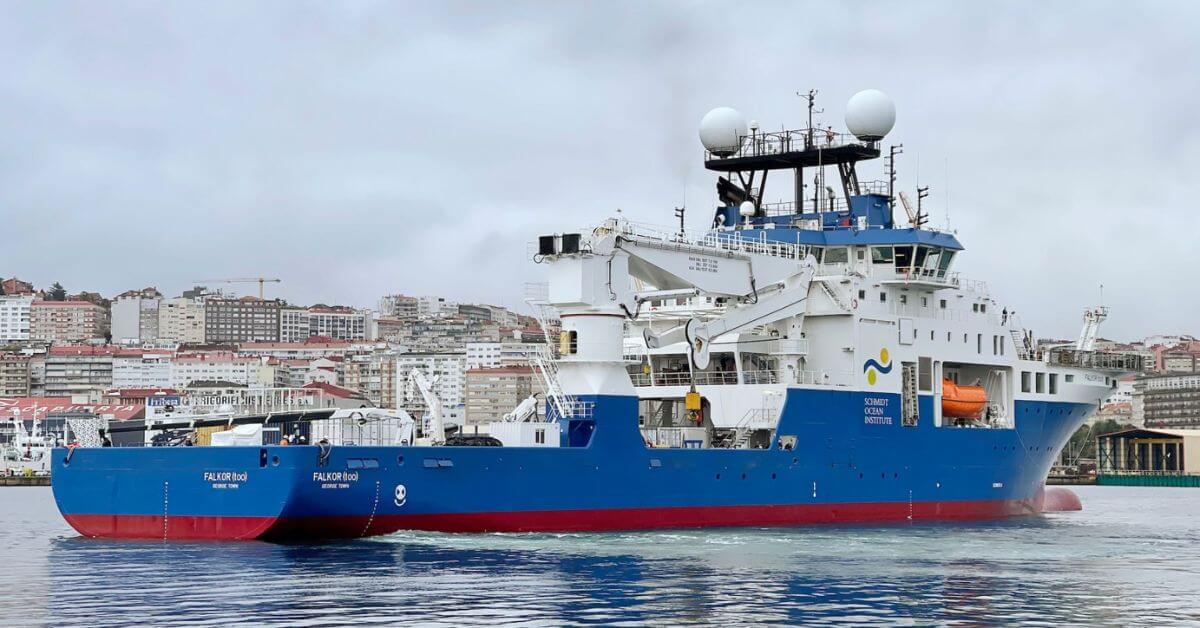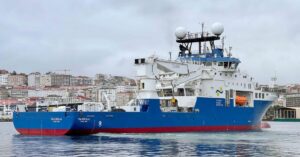
Baltimore Channel Reopens After Explosion On Bulk Carrier, Hatch Cover Retrieved
August 30, 2025
Containership Captain Faces $10,000 Warrant After Skipping Court Appearance
August 30, 2025

The international research expedition Uruguay SUB200, launched to explore the deep sea in Uruguay’s sovereign waters, was interrupted this week after the research vessel Falkor (too) suffered a technical failure.
The ship, operated by the Schmidt Ocean Institute (SOI), returned to the Port of Montevideo on Monday, August 25, for urgent repairs.
The malfunction occurred on Sunday afternoon, August 24, when the ship’s A-frame structure, which is essential for lowering and recovering heavy underwater equipment, stopped working while being raised from its stowed position to vertical. According to SOI, such incidents are very rare, and no one on board was injured.
Project coordinator Leticia Burone explained that the A-frame is a critical device for the expedition’s operations. Once repairs are complete, the ship is expected to resume scientific activities at Station 3, located on the slopes of the Río de la Plata Canyon, where work was interrupted.
The Universidad de la República (Udelar), which is part of the project, said in a statement that the team was forced to return to port to fix technical issues but hoped repairs would be completed soon.
Organisers added that during the stay in Montevideo, crew members will not disembark, and no press activities with the scientists are planned.
COMUNICADO DEL EQUIPO DE #URUGUAYSUB200
El Falkor (too) está volviendo a puerto para resolver fallas técnicas.
Estaremos actualizando la información a través de nuestras redes.
Pronto la expedición estará nuevamente explorando y transmitiendo en vivo
pic.twitter.com/MEiHw411it
— Universidad de la República (@Udelaruy) August 24, 2025
The research vessel Falkor (too) left Montevideo on August 22 with 37 scientists and technicians from 18 institutions in six countries. The month-long mission, called “Uruguay SUB200: Journey into the Unknown,” planned to study about 50 sites on the seabed, located 200–300 kilometers off Uruguay at depths of 200 to 3,500 meters.
The mission’s objectives include studying marine ecology, underwater archaeology, deep-sea mapping, and marine geophysics. A key feature was to share progress with the public through live broadcasts and high-quality images captured by the ship’s remotely operated vehicle (ROV) SuBastian, which can dive to 4,500 meters.
The Falkor (too) is one of the world’s most advanced oceanographic research vessels. Built in 2011 as the offshore ship Polar Queen for Norway’s GC Rieber Shipping ASA, it was later acquired by the Schmidt Ocean Institute (SOI) and converted into a modern research ship.
The vessel is 110 meters long, 20 meters wide, and has space for 70 people. It is equipped with eight labs, a heavy-duty stern crane, multibeam sonars, acoustic sensors, high-definition cameras, cold labs for biological work, and systems to study microplastics, sediment, and water chemistry. A high-performance computing system processes oceanographic data.
The ship can stay at sea for 60 to 120 days and carries on the legacy of SOI’s original research vessel Falkor, which was donated to Italy’s National Research Council in 2022.
Earlier this year, the Class C polar-certified vessel carried out its first science expedition to Antarctica. Just this month, it completed a three-week Argentinian-led survey of the Mar del Plata Submarine Canyon, located 300 kilometers offshore and known as one of Argentina’s largest underwater canyons.
According to SOI, once repairs are completed, the Falkor (too) will resume its role in global scientific research. Its 2025 program includes expeditions across the South Atlantic, with stops planned in Antarctica, South Georgia, the South Sandwich Islands, the Mar del Plata Canyon, and deep waters off Uruguay.
Reference: mercopress
Source: Maritime Shipping News


